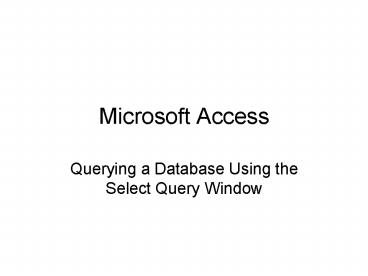Microsoft Access PowerPoint PPT Presentation
1 / 19
Title: Microsoft Access
1
Microsoft Access
- Querying a Database Using the Select Query Window
2
Objectives
- Creating and running queries
- Using compound criteria in queries
- Sorting data in queries
- Using a saved query
- Joining tables in queries
- Performing calculations in queries
- Using a grouping in queries
3
Types of Queries
- Queries can be used to view, and analyze
information in a database - In addition, update queries can be used to change
data - Types of queries
- Select queries
- Parameter queries
- Update queries
- Crosstab queries
- Saved queries can be used to generate reports
4
Creating Select Queries
- Most common of all queries. Data can be retrieved
from one or more tables results are displayed in
datasheet view - Select a basis table for the query
- Click on the New Object button arrow, and select
Query - Select Design View and click OK
- Double click on basis table fields to insert them
into the query - Run the query
5
Select Query Datasheet View
6
Creating Parameter Queries
- Parameter queries prompt a user for search
criteria with its own dialog box - Start with a Select Query, and save as Client
Parameter Query - Add bracketed text in a criteria field to prompt
the user for parameter value
7
Parameter Query Datasheet View
8
Creating Update Queries
- Update queries are used to make global data
changes in one or more tables - Start with a select query, save as Client Update
Query - In the Query menu, select Update Query
- Enter the new value in the Update To field
- Enter the old value to search for in the Criteria
field - Run the query, confirm changes
9
Review Changed Database
- All occurrences of 53 in the Trainer Number field
have been updated to 42 in the Client table
10
Creating Crosstab Queries
- Crosstab queries are used to display aggregate
data (such as count, total, average) in matrix
format - Start with a Select Query, save as Client
Crosstab Query - In the Query menu, select Crosstab Query
- Select Clear Grid in the Edit menu
- Double click the City, Trainer Number, and Amount
Paid fields from the Client table - Add a field named Total Paid Amount Paid
- Refer to the picture for the Total and Crosstab
settings - Run the query, confirm aggregate data is
correctly displayed
11
Crosstab Query Datasheet View
12
Using a Saved Query for Reports
- A saved query can be used for generating reports
- Select a saved query listed in Queries Objects
- Click on the New Object button arrow and select
Report - Select Report Wizard and click OK
- Pick fields you wish to see on the report
- Can add grouping level(s)
- Can sort records by up to four fields
- Specify layout and style, and save the report
- Click Finish to generate report
13
Using Compound Criteria in Queries
- Queries can contain compound search criteria
- AND clauses are specified by entering criteria on
the same row across different fields - OR clauses are specified by entering criteria on
rows below other fields - Can combine AND with OR clauses
- Can use wildcards to specify groups of items
- Specifies clients whose names start with an F AND
has paid less than 20000, OR any Client Number
that starts with a CE
14
Compound Criteria Datasheet View
15
Sorting Data in Queries
- Any field in a query can be sorted in ascending
or descending order - In Design View, look for the field to sort by
(i.e. Amount Paid) - Click on the Sort pull-down menu, and select
Ascending or Descending - Run the Query, and confirm data was sorted
properly
16
Data Sorted by Amount Paid
17
Joining Tables in Queries
- Data needed for queries often reside on different
tables. A join allows queries to retrieve
relevant records from related tables - Use the Trainer table as basis for a new query,
and add the Client table into the query. Trainer
Number joins the two tables in the query
18
Trainer and Client Tables Joined by Trainer Number
19
Performing Calculations in Queries
- Create a new field to display calculations based
on the values of fields in a database - Within Design View
- Type an expression in an empty cell in the Field
row - Field names must be bracketed (i.e. Amount
Paid) - The following calculates the Taxes Paid by
multiplying the Amount Paid by the CA sales tax
rate

